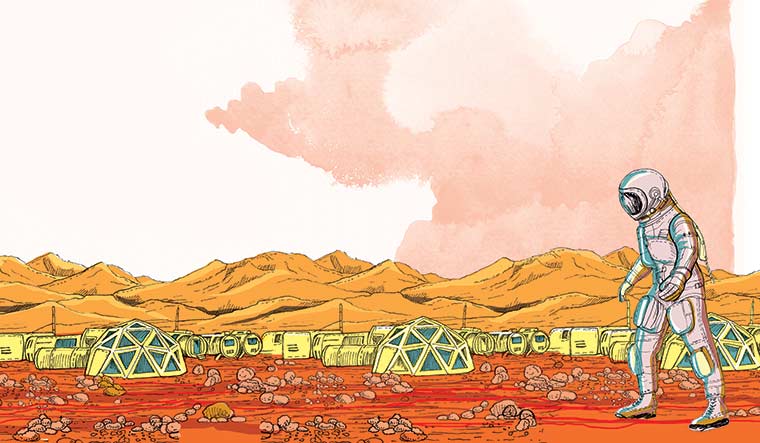A while back, my husband and I rode in a custom-built submarine, 400m below the surface of the ocean. The experience was both awe-inspiring and humbling. To know that a bubble of thick acrylic and some metal was all that kept us alive, I imagine this is what astronauts feel like. The bottom of the ocean is as strange, beautiful and inhospitable as outer space, but that does not keep us from wanting to visit it.
That same drive to risk our lives by exploring the unknown is what carries us beyond the earth’s atmosphere. Science fiction loves the idea of humanity settled beyond our planet—to boldly go to new frontiers, to sail the solar winds as we once did across the seas, and to establish families and cultures in a new land. Reality, unfortunately, has shown that the analogy fails in many ways. Space is far more hostile than the ocean or an uninhabited island. For humanity to successfully expand off our home planet, we will need to solve some fundamental issues of biology and physics, and those solutions will determine when and how we settle in other parts of the solar system.
Cosmic and solar radiation will be the greatest challenges for our bodies. Exposure to these leads to all kinds of physiological problems, which we are still in the process of discovering as astronauts spend more time on the International Space Station. On the other hand, biotechnology is booming and a combination of genetic engineering and nano-scale devices may be able to counteract the detrimental effects of radiation in the future.
A breathable atmosphere is another major problem once we leave earth. The current Martian atmosphere is stormy and full of carbon dioxide. People have also considered terraforming the planet, which is geo-engineering the planet to have a more earth-like climate and atmosphere. While there have been many proposed ways of achieving this, none of them seems likely to happen in the near future. We are discovering that climate and weather are chaotic enough that we struggle to affect them here on earth. Whatever we try on Mars may not go the way we planned, in terms of outcome or timescale.
The moon has almost no atmosphere. Science fiction has envisioned us living in domed cities, either very large structures, or smaller hemispheres connected by tunnels. This might be easier on the moon than Mars. Martian settlements are likely to have extensive undergrounds facilities so that humans can take shelter during storms. Both places would need easy access to emergency spacesuits. In an ideal future, the clothing that settlers wear could double as protection against cold and vacuum, so that only a helmet and air source are necessary supplies for emergencies.
Water, another ingredient for life, exists on both the moon and Mars. It will have to be taken from the ground or towed in from asteroids. Luckily, water can serve multiple purposes. In addition to keeping us, our food, and our animals hydrated, it can protect against radiation, and it can be broken down for energy and breathable oxygen. Any long-term settlement of space will likely require hefty amounts of water transportation, storage and recycling. Some of the technologies that would make those possible could also benefit humanity back on earth, where access to clean, fresh water is already becoming a problem.
This leads to the next major facet of getting humanity to thrive outside: transportation. Moving hard goods away from the gravity wells of earth, and even Mars, poses a major challenge due to the fuel requirements. Unless we finally discover a way to cheat gravity or have the material strength for space elevators, we will need a way to move both people and materials back and forth. For now, reusable rockets look like our best bet, and they are likely to become more efficient as time goes on. The journey to Mars proves a huge obstacle, with 7 to 9 months of travel time each way. Once we have a foothold established on and around the moon, and after we have a settlement in orbit around Mars, we can build larger vehicles in space that act as ferries. While this will not reduce the time, it will enable us to carry much larger groups of people back and forth.
Ultimately, though, settlements on the moon and Mars will need to become self-sufficient. The primary exchanges of value could be information, or technological advancements, rather than hard goods. It is far less costly to transmit ideas, and we will have a space network to communicate effectively, whether by radio waves or laser. The earth and moon will have a closer exchange of both goods and ideas, with the moon receiving a lot of initial support. Martian settlers will have to fend for themselves and cope with greater tragedy, as well, when something goes wrong.
I expect that we will establish ourselves on the moon before Mars, in large part due to its proximity to the earth. Unlike in centuries past, the pioneers of tomorrow probably will not be the poor or the discontent looking for a better life. Initial ventures are likely to be commercial and scientific, followed by tourism. Much like going to Antarctica or under the sea, tourists with specific training and gear will be the first non-astronauts to leave the planet. Eventually, the staff required to support the tourists and scientists will form the longer-term settlements. Mining, chemistry, botany and engineering will be the skills on order for the pioneers.
Eventually, we will have to cross the biggest hurdle: pregnancy and childbirth. This is a less popular topic for science and science fiction, but it is a necessary fact for true expansion into the solar system. We are just beginning to look at what happens to embryonic cells on the ISS. Will gestation happen normally in low gravity? How will we mitigate radiation effects on a foetus? What about nutritional challenges? After birth, we will have to deal with breastfeeding and child development. The generations that grow up on the moon or Mars may never be able to return to earth due to their low-gravity-adapted physiology.
Once we begin to settle people on the moon or Mars or beyond, the off-world societies will develop their own cultures in addition to their physical changes. As any adventurer knows, those who explore must be adaptable, courageous and resourceful. Human beings have always loved to push boundaries and outer space calls to us in spite of its dangers. We are an ingenious species. I have no doubt that we will find a way to answer that call.
***
Now that we have covered some of the practical challenges, let us dream a little. Say we have moved past the initial settlement stage to a time when small cities exist on the moon and Mars. What might a regular day look like for a family on Luna, the biggest city on the moon? Consider this...
You wake up and unhook your sleeping web. Your spouse snores gently in the adjacent web, and you close the folding divider behind you as you go into the living space of your cramped quarters. Your daughter, one of the first children born on Luna, and your mother sit on the sofa, drinking their breakfast.
“Good morning,” you say, bouncing over to your child and kissing her head. At seven, she is taller than her Earth-born grandmother and is catching up to you. You grab your own breakfast from the cold-storage cabinet. A vigorous few shakes warms it up. As you sip, you check the readouts on your sleeve: your blood looks healthy, and your radiation exposure has been sufficiently counteracted. The shake contains artificial vitamins that help repair your DNA and keep your nutrients in balance.
You and your daughter bounce your way to her school, on the fourth floor of your residential tower, then you continue upward and catch a shuttle to your job on one of the orbital manufacturing stations. You spend the day on inventory, sorting through the latest arrivals from the asteroid miners, making sure the raw materials go to the appropriate refineries on the moon’s surface. You have a small window with a view of the giant ferry to Mars. Three more weeks to departure. The passengers have all arrived, mostly from Earth, but a handful are from the moon. All of them will live on board the ferry until they leave.
At the end of your work shift, you catch a ride back down, gazing at the towers of Luna that rise from the moon’s surface. The buildings are painted in soft colours. Covered bridges connect the upper levels. In the distance, the Earth hangs in the black sky.
Before you go home, you spend an hour in the high-gravity gym. The gyroscopic machines are set to produce an Earth-gravity resistance, to help your cardiovascular system and bone density. After enough exercise, a green check mark appears on your sleeve. You clean yourself with mist and a wipe down—bathing is an Earth luxury.
Also read
- National Space Day: Why it is a significant milestone in India's space journey
- Chandrayaan-3: 2 of 3 objectives achieved. What’s next
- Watch: ISRO shares video of Pragyan rover ramping down from Vikram lander
- Chandrayaan-3: Rover 'Pragyan' rolls out. See images captured by 'Vikram' lander
- Chandrayaan-3's Tamil connect: The soil from Nammakal and the three scientists
At home, your husband greets you with a grin and a bowl of mung bean noodles, dotted with fresh tomatoes and coriander. He works in the greenhouse, so he gets first choice of the food grown there. Lucky for you, he also likes to cook. Your daughter eats them like the lunar native she is, flicking the food into her mouth with chopstick, but your mother slurps from a covered bowl so the noodles do not fly everywhere. She might never fully adjust to living in such low gravity.
After dinner, your tuck your daughter into her web.
“Good night,” you say. “What do you do if the alarm sounds?”
With a resigned look, she repeats the instructions you have given her every night since she was three: open the web, wear the helmet and the gloves, touch the Seal button, then put the oxygen pack on, connect the hose, and wait for an adult.
Satisfied, you give her a kiss, then settle outside the bedroom to catch up on the news. People on Earth are angry about another Martian village that was destroyed in an unexpected storm. Some politicians there think it is too dangerous and costly to live there and want to stop the next ferry. You shrug it off. Accidents and death are part of living in space. Earth people are too easily upset over these things. You only visited the planet once after your parents came to Luna. You were 20 then, and you did not much like it there. Everything felt too big, and the colours were so bright, and walking was such an effort.
You switch to a movie, putting it on the wall screen so everyone can watch. A smile comes onto your mother’s face. Small films have been produced on the moon, but most of them still come from Earth. Somehow, seeing all that green and blue on a screen is not as hard as dealing with it in real life. Your husband brings some imported popcorn to the sofa and tosses a kernel into the air. It floats gently toward you, and you catch it easily. Corn is a luxury item from Earth. You savour its taste and settle back to watch the movie, marveling at the strangeness of life on Earth.





